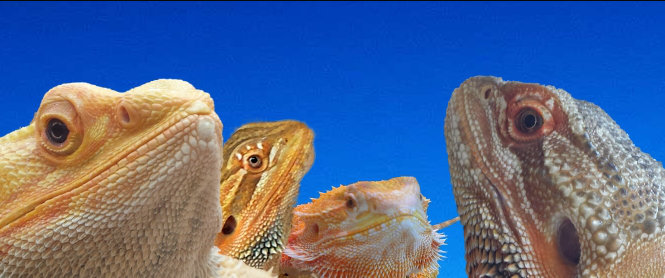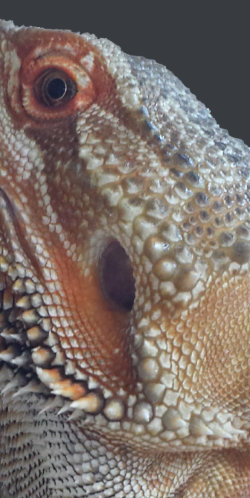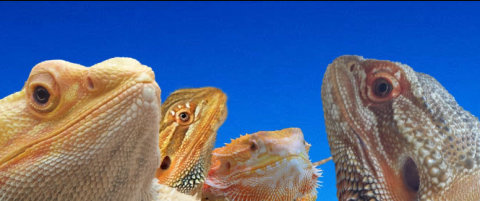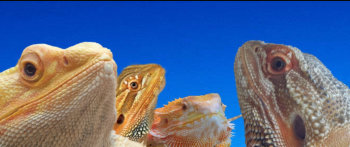

Over the last twenty years or so
the Bearded Dragon, or as it is
correctly known the Inland or
Central Bearded Dragon has leg
waved and head bobbed itself
into reptile keepers affections all
round world.
Bearded Dragons are a medium
sized lizard allowing easy if
occasionally spiky handling.

© Steladragons.co.uk

Bearded dragons are naturally found in the deserts and semi-arid scrub
lands of south-eastern Australia. They did not commonly appear in the
pet trade until the early 1990s, but since then their popularity has grown
exponentially. They are generally easy to maintain, have gentle
dispositions, grow to a manageable size (approximately two feet long),
are extremely hardy, and can live over 10 years. Many hobbyists are
attracted to these reptiles because of their dinosaur-like appearance.
They look like they are covered with tiny, spiky scales, but they are still
quite pleasant to the touch and enjoy being handled.
One behavioural trait that makes bearded dragons so appealing is their
arm waving. Hatchling and baby beardies will sometimes sit and raise
one of their forelimbs above their head, and then slowly lower it back
down. While the real reason for this waving is related to introducing
themselves as non-threatening to other dragons, it can appear as if they
are waving "Hello" to you. Other appealing behavioural traits include
head bobbing and stacking (one dragon perching on top of another).
Bearded dragons come in a variety of colours such as; brown, grey,
reddish-brown, red, yellow, white and orange. They are capable of
undergoing very slight changes in the shade of their colour to help
regulate temperature. These specialized scales are along there neck,
throat, head, back, and there tail.
When a Bearded Dragon feels threatened, it will flatten its body, puff out
its throat, and open its mouth to make it appear larger. This is how they
got their name because it looks like a beard and since it flattens out and
looks bigger that is how it got the dragon part of its name.
The Bearded Dragon's diet.
Bearded dragons eat fruits and vegetables as well as insects, which
makes them omnivorous. When feeding a bearded dragon you need to
make sure that you can provide live insects as well as fruits and
vegetables. One without the other means an unhealthy Beardie.
Age should always be taken into consideration when feeding a bearded
dragon. Baby and juvenile Beardies need to have more proteins in the
diet to supplement for growing bones and tissues, but they should still
be provided with veggies. An adult bearded dragon diet should consist of
mostly fruits and veggies.
Baby bearded dragons should be given as many live insects as they will
eat within 15 minutes, all uneaten insects should be removed. This
should be done every day. But, you're not getting away with just live
insects when raising a bearded dragon. You should still provide them
with fruits and vegetables DAILY, even if they don't eat them. Having the
vegetation in the tank with them, will get them used to seeing it, so when
they are older they will be more likely to eat the veggies.
As for adults, they can be given live insects two to three times a week,
and again, never leave uneaten insects in the enclosure. So, after about
fifteen minutes, remove the uneaten insects. As for fresh fruits and
vegetables, provide them daily.

About Bearded Dragons

Steladragons.co.uk


Over the last twenty years or so the Bearded Dragon, or as it is
correctly known the Inland or Central Bearded Dragon has leg
waved and head bobbed itself into reptile keepers affections
all round world.
Bearded Dragons are a medium sized lizard allowing easy if
occasionally spiky handling.

© Steladragons.co.uk
Bearded dragons are naturally found in the deserts and
semi-arid scrub lands of south-eastern Australia. They did
not commonly appear in the pet trade until the early
1990s, but since then their popularity has grown
exponentially. They are generally easy to maintain, have
gentle dispositions, grow to a manageable size
(approximately two feet long), are extremely hardy, and
can live over 10 years. Many hobbyists are attracted to
these reptiles because of their dinosaur-like appearance.
They look like they are covered with tiny, spiky scales, but
they are still quite pleasant to the touch and enjoy being
handled.
One behavioural trait that makes bearded dragons so
appealing is their arm waving. Hatchling and baby
beardies will sometimes sit and raise one of their
forelimbs above their head, and then slowly lower it back
down. While the real reason for this waving is related to
introducing themselves as non-threatening to other
dragons, it can appear as if they are waving "Hello" to
you. Other appealing behavioural traits include head
bobbing and stacking (one dragon perching on top of
another).
Bearded dragons come in a variety of colours such as;
brown, grey, reddish-brown, red, yellow, white and
orange. They are capable of undergoing very slight
changes in the shade of their colour to help regulate
temperature. These specialized scales are along there
neck, throat, head, back, and there tail.
When a Bearded Dragon feels threatened, it will flatten
its body, puff out its throat, and open its mouth to make
it appear larger. This is how they got their name because
it looks like a beard and since it flattens out and looks
bigger that is how it got the dragon part of its name.
The Bearded Dragon's diet.
Bearded dragons eat fruits and vegetables as well as
insects, which makes them omnivorous. When feeding a
bearded dragon you need to make sure that you can
provide live insects as well as fruits and vegetables. One
without the other means an unhealthy Beardie.
Age should always be taken into consideration when
feeding a bearded dragon. Baby and juvenile Beardies
need to have more proteins in the diet to supplement for
growing bones and tissues, but they should still be
provided with veggies. An adult bearded dragon diet
should consist of mostly fruits and veggies.
Baby bearded dragons should be given as many live
insects as they will eat within 15 minutes, all uneaten
insects should be removed. This should be done every
day. But, you're not getting away with just live insects
when raising a bearded dragon. You should still provide
them with fruits and vegetables DAILY, even if they don't
eat them. Having the vegetation in the tank with them,
will get them used to seeing it, so when they are older
they will be more likely to eat the veggies.
As for adults, they can be given live insects two to three
times a week, and again, never leave uneaten insects in
the enclosure. So, after about fifteen minutes, remove
the uneaten insects. As for fresh fruits and vegetables,
provide them daily.

About Bearded Dragons

Steladragons.co.uk


Over the last twenty years or so
the Bearded Dragon, or as it is
correctly known the Inland or
Central Bearded Dragon has leg
waved and head bobbed itself
into reptile keepers affections all
round world.
Bearded Dragons are a medium
sized lizard allowing easy if
occasionally spiky handling.

© Steladragons.co.uk
Bearded dragons are naturally found in the
deserts and semi-arid scrub lands of south-
eastern Australia. They did not commonly
appear in the pet trade until the early 1990s, but
since then their popularity has grown
exponentially. They are generally easy to
maintain, have gentle dispositions, grow to a
manageable size (approximately two feet long),
are extremely hardy, and can live over 10 years.
Many hobbyists are attracted to these reptiles
because of their dinosaur-like appearance. They
look like they are covered with tiny, spiky
scales, but they are still quite pleasant to the
touch and enjoy being handled.
One behavioural trait that makes bearded
dragons so appealing is their arm waving.
Hatchling and baby beardies will sometimes sit
and raise one of their forelimbs above their
head, and then slowly lower it back down.
While the real reason for this waving is related
to introducing themselves as non-threatening to
other dragons, it can appear as if they are
waving "Hello" to you. Other appealing
behavioural traits include head bobbing and
stacking (one dragon perching on top of
another).
Bearded dragons come in a variety of colours
such as; brown, grey, reddish-brown, red,
yellow, white and orange. They are capable of
undergoing very slight changes in the shade of
their colour to help regulate temperature. These
specialized scales are along there neck, throat,
head, back, and there tail.
When a Bearded Dragon feels threatened, it
will flatten its body, puff out its throat, and
open its mouth to make it appear larger. This is
how they got their name because it looks like a
beard and since it flattens out and looks bigger
that is how it got the dragon part of its name.
The Bearded Dragon's diet.
Bearded dragons eat fruits and vegetables as
well as insects, which makes them omnivorous.
When feeding a bearded dragon you need to
make sure that you can provide live insects as
well as fruits and vegetables. One without the
other means an unhealthy Beardie.
Age should always be taken into consideration
when feeding a bearded dragon. Baby and
juvenile Beardies need to have more proteins in
the diet to supplement for growing bones and
tissues, but they should still be provided with
veggies. An adult bearded dragon diet should
consist of mostly fruits and veggies.
Baby bearded dragons should be given as many
live insects as they will eat within 15 minutes,
all uneaten insects should be removed. This
should be done every day. But, you're not
getting away with just live insects when raising
a bearded dragon. You should still provide them
with fruits and vegetables DAILY, even if they
don't eat them. Having the vegetation in the
tank with them, will get them used to seeing it,
so when they are older they will be more likely
to eat the veggies.
As for adults, they can be given live insects two
to three times a week, and again, never leave
uneaten insects in the enclosure. So, after about
fifteen minutes, remove the uneaten insects. As
for fresh fruits and vegetables, provide them
daily.














